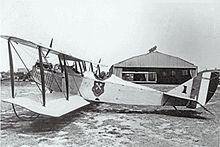Alabama Air National Guard
| Alabama Air National Guard | |
|---|---|
Brigadier General Edward D. Casey (Chief of Staff-Air) | |
| Aircraft flown | |
| Fighter | F-35A Lightning II |
| Tanker | KC-135R Stratotanker |
The Alabama Air National Guard (AL ANG) is the aerial militia of the State of Alabama, United States of America. It is, along with the Alabama Army National Guard, an element of the Alabama National Guard.
As state militia units, the units in the Alabama Air National Guard are not in the normal
Overview
Under the "Total Force" concept, Alabama Air National Guard units are considered to be Air Reserve Components (ARC) of the
Along with their federal reserve obligations, as state militia units the elements of the Alabama ANG are subject to being activated by order of the governor to provide protection of life and property, and preserve peace, order and public safety. State missions include disaster relief in times of earthquakes, hurricanes, floods and forest fires, search and rescue, protection of vital public services, and support to civil defense.
Components
The Alabama Air National Guard consists of the following major units:
- Established 21 January 1922 (as: KC-135R Stratotanker
- Stationed at: Sumpter Smith Air National Guard Base, Birmingham
- Gained by: Air Mobility Command
- The 117th Air Refueling Wing flies the Boeing KC-135R Stratotanker. Its mission is to train and equip combat ready aircrews and support personnel to perform worldwide aerial refueling and airlift missions.[1]
- Established 1 October 1947 (as: F-16C/D Fighting Falcon
- Stationed at: Dannelly Field Air National Guard Base (aka Montgomery Regional Airport), Montgomery
- Gained by: Air Combat Command
- Flies counter narcotics aircraft[2]
- Established 18 June 1954 (as: 225th Radio Relay Squadron)
- Stationed at Abston Air National Guard Station; Montgomery
- Gained by: Air Combat Command
- The Group commands, organizes, trains, equips, and administers expeditionary communications squadrons.
History
Origins
The Alabama Air National Guard origins date to 27 August 1917 with the establishment of the 106th Aero Squadron as part of the

The
The squadron was reformed on 21 January 1922 as the 125th Squadron, Alabama National Guard, received federal recognition as a Corps Aviation unit. (It was re-designated the 135th Observation Squadron on 25 January 1923 and then it was re-designated the 114th Observation Squadron as an aviation unit the 39th Division on 1 May 1923. On 16 January 1924, it was re-designated the 106th Observation Squadron as an aviation unit in the 31st Division.) Maj.
The 106th Observation Squadron was ordered into active service on 125 November 1940 as part of the buildup of the Army Air Corps prior to the United States entry into World War II.
Alabama Air National Guard
On 24 May 1946, the United States Army Air Forces, in response to dramatic postwar military budget cuts imposed by President Harry S. Truman, allocated inactive unit designations to the National Guard Bureau for the formation of an Air Force National Guard. These unit designations were allotted and transferred to various State National Guard bureaus to provide them unit designations to re-establish them as Air National Guard units.[5]
The modern Alabama ANG received federal recognition on 25 November 1946 as the 106th Bombardment Squadron (Light) at
On 1 October 1947 the 117th Fighter Group allotted by the National Guard Bureau, extended federal recognition and activated at Birmingham, with the 106th Bomb Squadron being assigned to the unit. The 160th Fighter Squadron at Montgomery was authorized by the National Guard Bureau and recognized also on 1 October 1947. The 160th was equipped with the F-51D Mustang and its mission was the air defense of the state. On 15 October 1962, the 160th Tactical Reconnaissance Squadron was authorized to expand to a group level, and the 187th Tactical Reconnaissance Group was established by the National Guard Bureau. The 160th TRS becoming the group's flying squadron.

In 2007, the Alabama legislature requested the National Guard Bureau to allow the Alabama Air National Guard 160th Fighter Squadron to be re-designated as the 100th Fighter Squadron so the state could honor the legacy of the World War II Tuskegee Airmen. This was obtained from the Air Force and on 12 September 2009, the 100th Flying Training Squadron was inactivated. The designation was transferred to the National Guard Bureau by the Air Force and it was allotted to the Alabama ANG. As a result, the 160th Fighter Squadron was inactivated, and the new 100th Fighter Squadron assumed its personnel, equipment and aircraft.
Today, the 117th Air Refueling Wing (117 ARW) provides aerial refueling support to Air Force, Navy and Marine Corps and allied nation aircraft. The 187th Fighter Wing (187 FW) operated the F-16 Fighting Falcon and deploys around the world as part of Air Expeditionary Forces.
After the
Role in the Bay of Pigs Invasion
According to information from
Notable personnel
- In late 1972 and early 1973, he drilled with the 187th Fighter Wing.
- Mal Moore, University of Alabama Athletic Director
See also
References
![]() This article incorporates public domain material from the Air Force Historical Research Agency
This article incorporates public domain material from the Air Force Historical Research Agency
- ^ 117th Air Refueling Wing website
- ^ 187th Fighter Wing website
- ^ ANG Chronology 1908–2007, see also Brief History of the Minnesota Air National Guard and the 133rd Airlift Wing, 1.
- ^ "117th ARW History page". Archived from the original on 14 February 2013. Retrieved 4 January 2013.
- ^ a b Rosenfeld, Susan and Gross, Charles J (2007), Air National Guard at 60: A History. Air National Guard history program AFD-080527-040 Archived 13 February 2016 at the Wayback Machine
- Gross, Charles J (1996), The Air National Guard and the American Military Tradition, United States Dept. of Defense, ISBN 0160483026
- Alabama Air National Guard website


